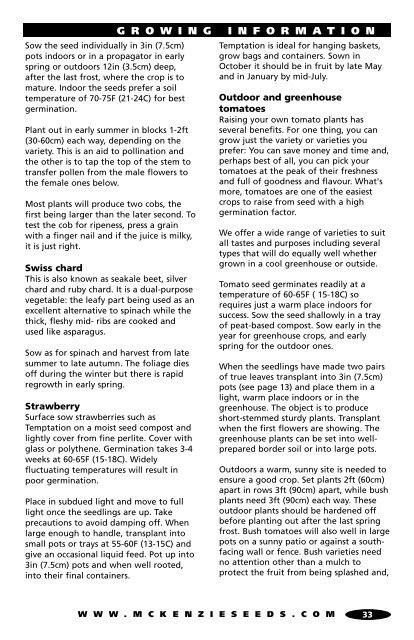Seed Guide 2007 pgs 01/41 - McKenzie Seeds
Seed Guide 2007 pgs 01/41 - McKenzie Seeds
Seed Guide 2007 pgs 01/41 - McKenzie Seeds
You also want an ePaper? Increase the reach of your titles
YUMPU automatically turns print PDFs into web optimized ePapers that Google loves.
Sow the seed individually in 3in (7.5cm)<br />
pots indoors or in a propagator in early<br />
spring or outdoors 12in (3.5cm) deep,<br />
after the last frost, where the crop is to<br />
mature. Indoor the seeds prefer a soil<br />
temperature of 70-75F (21-24C) for best<br />
germination.<br />
Plant out in early summer in blocks 1-2ft<br />
(30-60cm) each way, depending on the<br />
variety. This is an aid to pollination and<br />
the other is to tap the top of the stem to<br />
transfer pollen from the male flowers to<br />
the female ones below.<br />
Most plants will produce two cobs, the<br />
first being larger than the later second. To<br />
test the cob for ripeness, press a grain<br />
with a finger nail and if the juice is milky,<br />
it is just right.<br />
Swiss chard<br />
This is also known as seakale beet, silver<br />
chard and ruby chard. It is a dual-purpose<br />
vegetable: the leafy part being used as an<br />
excellent alternative to spinach while the<br />
thick, fleshy mid- ribs are cooked and<br />
used like asparagus.<br />
Sow as for spinach and harvest from late<br />
summer to late autumn. The foliage dies<br />
off during the winter but there is rapid<br />
regrowth in early spring.<br />
Strawberry<br />
Surface sow strawberries such as<br />
Temptation on a moist seed compost and<br />
lightly cover from fine perlite. Cover with<br />
glass or polythene. Germination takes 3-4<br />
weeks at 60-65F (15-18C). Widely<br />
fluctuating temperatures will result in<br />
poor germination.<br />
Place in subdued light and move to full<br />
light once the seedlings are up. Take<br />
precautions to avoid damping off. When<br />
large enough to handle, transplant into<br />
small pots or trays at 55-60F (13-15C) and<br />
give an occasional liquid feed. Pot up into<br />
3in (7.5cm) pots and when well rooted,<br />
into their final containers.<br />
G R O W I N G I N F O R M A T I O N<br />
Temptation is ideal for hanging baskets,<br />
grow bags and containers. Sown in<br />
October it should be in fruit by late May<br />
and in January by mid-July.<br />
Outdoor and greenhouse<br />
tomatoes<br />
Raising your own tomato plants has<br />
several benefits. For one thing, you can<br />
grow just the variety or varieties you<br />
prefer: You can save money and time and,<br />
perhaps best of all, you can pick your<br />
tomatoes at the peak of their freshness<br />
and full of goodness and flavour. What's<br />
more, tomatoes are one of the easiest<br />
crops to raise from seed with a high<br />
germination factor.<br />
We offer a wide range of varieties to suit<br />
all tastes and purposes including several<br />
types that will do equally well whether<br />
grown in a cool greenhouse or outside.<br />
Tomato seed germinates readily at a<br />
temperature of 60-65F ( 15-18C) so<br />
requires just a warm place indoors for<br />
success. Sow the seed shallowly in a tray<br />
of peat-based compost. Sow early in the<br />
year for greenhouse crops, and early<br />
spring for the outdoor ones.<br />
When the seedlings have made two pairs<br />
of true leaves transplant into 3in (7.5cm)<br />
pots (see page 13) and place them in a<br />
light, warm place indoors or in the<br />
greenhouse. The object is to produce<br />
short-stemmed sturdy plants. Transplant<br />
when the first flowers are showing. The<br />
greenhouse plants can be set into wellprepared<br />
border soil or into large pots.<br />
Outdoors a warm, sunny site is needed to<br />
ensure a good crop. Set plants 2ft (60cm)<br />
apart in rows 3ft (90cm) apart, while bush<br />
plants need 3ft (90cm) each way. These<br />
outdoor plants should be hardened off<br />
before planting out after the last spring<br />
frost. Bush tomatoes will also well in large<br />
pots on a sunny patio or against a southfacing<br />
wall or fence. Bush varieties need<br />
no attention other than a mulch to<br />
protect the fruit from being splashed and,<br />
W W W . M C K E N Z I E S E E D S . C O M<br />
33


